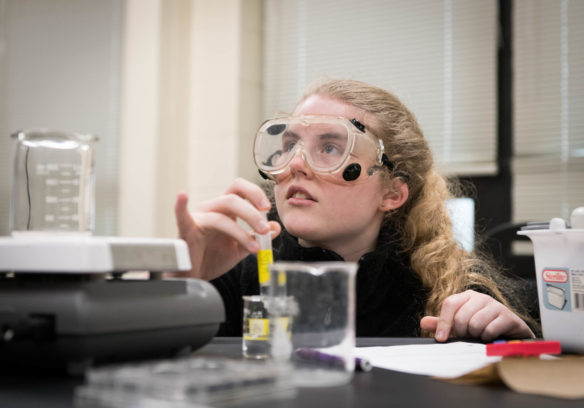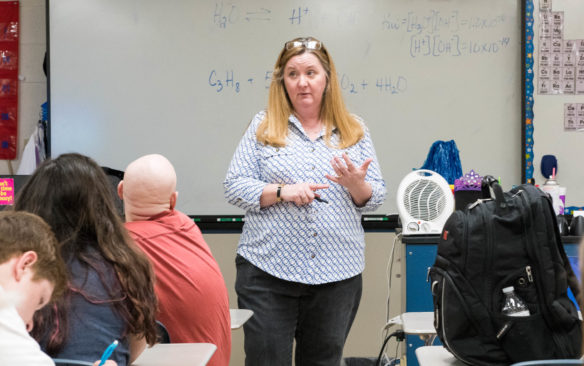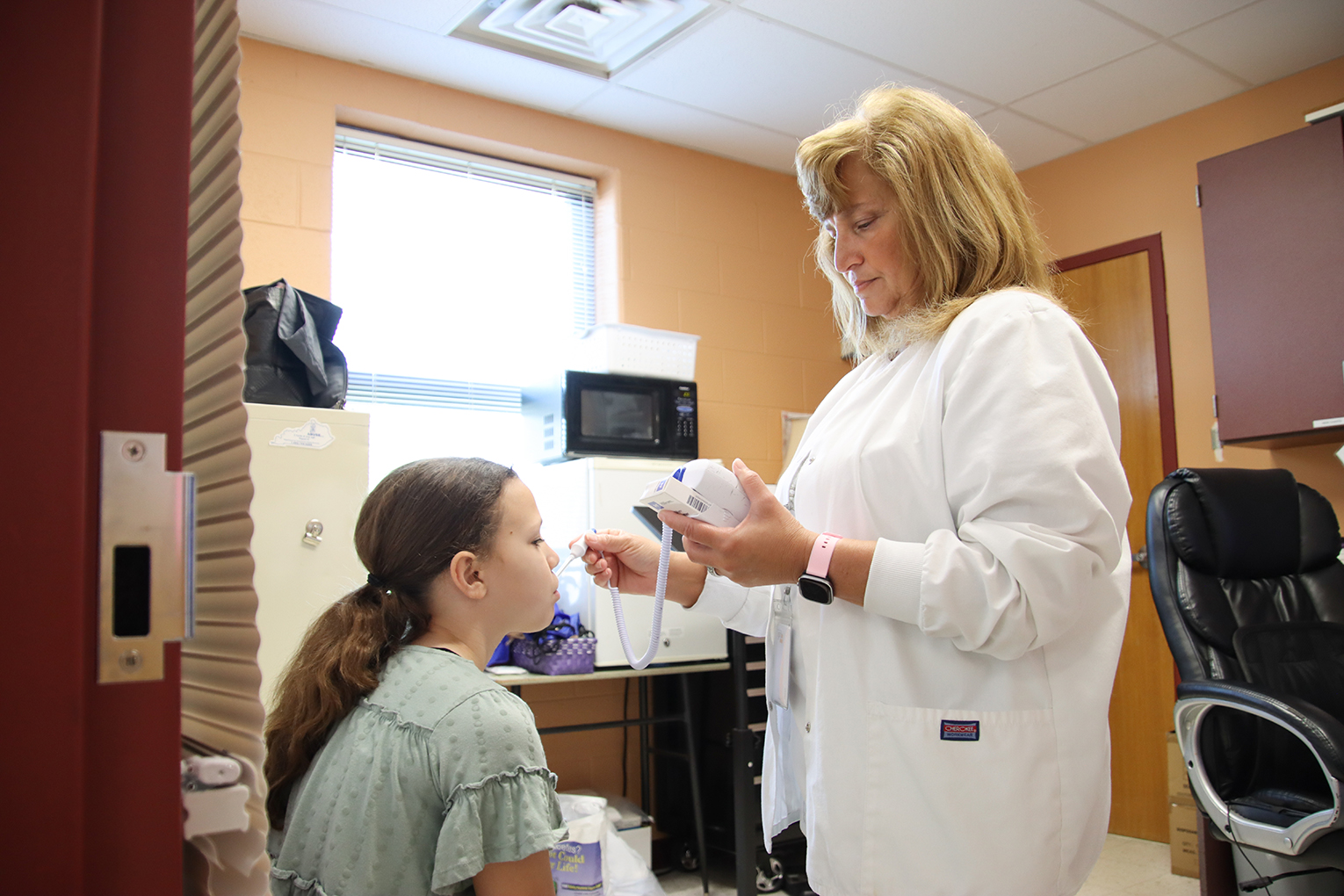
Elizabeth Burton, a junior at Simon Kenton High School (Kenton County) uses a syringe to mix chemicals while executing a through-course task in Deborah Brock’s chemistry class. Through-course tasks, which make up one of three major components in Kentucky’s new science assessment system, provide a way for students to demonstrate science skills.
Photo by Bobby Ellis, March 29, 2018
By Mike Marsee
mike.marsee@education.ky.gov
Deborah Brock and Dawn Reinhard were developing three-dimensional learning activities long before they were asked to use through-course tasks.
As they began to look at ways to teach the new science standards, the two chemistry teachers at Simon Kenton High School (Kenton County) began making changes to their lessons that looked very much like the through-course tasks that are now part of Kentucky’s science assessment system.
What they began to realize then – and what science teachers across Kentucky are beginning to realize now – is that the implementation of those tasks has led to changes in the way they are teaching and the way their students are learning.
“We’ve been moving toward making changes in this way for a long time. Before the first through-course tasks (TCTs) came out, we were trying to modify our lessons and assessments in such a way that students were held much more accountable for the understanding and the reasoning of the science and not just for the chemistry content,” Brock said.
“Using through-course tasks and using standards-based activities in our classroom has definitely changed the way that our students are learning. We’re focused more on how science and engineering practices can engage students in the chemistry content,” Reinhard added.
Melinda Curless, a science consultant with the Kentucky Department of Education (KDE), said that’s the kind of change that doesn’t come along every day.
“I think we’ve actually hit on something that’s changing instruction and that’s exciting,” said Curless, who has been involved with the development of TCTs from the beginning of the process.
TCTs are one of three components of a new science assessment system that is designed to measure students’ understanding at every step of the learning process. TCTs provide a way for students to demonstrate science skills and they also promote collaboration among teams of teachers, who discuss their students’ work and their own instructional practices.
A TCT might evaluate middle school students’ ability to explore factors that affect the growth of plants and other organisms or ask high school students to investigate whether viruses such as influenza are living things and to support their claims with evidence and reasoning.
“We have some teachers who see this as a great opportunity to focus on the science and engineering practices and the cross-cutting concepts in the science standards and to focus their work in a professional learning community (PLC),” said Caryn Walker, an elementary science goal clarity coach in the Jefferson County schools. “We have some teachers who have really embraced that, and they really see how that’s going to improve their science instruction.”
At Simon Kenton High, Reinhard and Brock said TCTs have taken the level of collaboration within their four-person chemistry department to a higher plane.
“We collaborate quite a bit in our department. However, I believe with the through-course tasks that collaboration is going a little bit deeper in terms of really trying to understand what our students are going to need to access the task,” Reinhard said.
“That discussion really leads into a much deeper analysis, and we can really discuss what our kids know and don’t know or can do or can’t do. It really helps us get to a deeper level of understanding for the kids,” Brock added.

Deborah Brock, a science teacher at Simon Kenton High School (Kenton County), talks with her class about a homework assignment. Science teachers in grades K-12 are required to use at least two through-course tasks with their students during the school year.
Photo by Bobby Ellis, March 29, 2018
Science teachers in grades K-12 are required to use at least two TCTs with their students during the school year. A KDE resource bank now includes at least three tasks for each grade level, and teams of teachers are continuing to work with KDE on the current tasks and develop new ones.
“We definitely want to praise all of the people who have engaged in this work,” said Christine Duke, a KDE science consultant. “It’s been very difficult work, very draining. Developing the tasks is not just about getting evidence of student learning, it’s about helping teachers understand what it’s like to teach three-dimensionally because it’s not familiar to them.”
“Looking back over this, it has probably been one of the most significant things in professional growth that I’ve done,” said Billy Betts, a science teacher at Wright Elementary School (Shelby County), who has been part of teacher development teams in each of the past two years. “The thing that I really enjoy is getting away from teaching about science to teaching how to do science.”
Ashlie Arkwright, a science teacher at the School for Creative and Performing Arts at Bluegrass (Fayette County), said she has enjoyed her role in developing TCTs even though it hasn’t been easy. She is nine months into the development of a second task with her partner teacher.
“It’s rigorous, it’s intense. The time on the front end to develop these is really significant. What’s coming out of it is really good and I really like what’s happening once it’s being implemented,” she said.
Duke said the teacher teams are developing stronger tasks as they become more experienced in the process.
“Teachers find that they’re more thorough and that the annotation documents are providing them with more information regarding the facilitation of the tasks,” Duke said. “They feel like they’re more directly aligned to the science and engineering practices and to the cross-cutting concepts. As we have grown in our understanding and our depth of knowledge of our standards, teams and consultants have developed a greater understanding and that’s very apparent in the second round of tasks.
“Some people used whatever was in the bank last year instead of using what’s there now, and they really need to take a look at what has been added. We as coaches are getting better, too, as we continue to work with more and more teachers.”
Duke said KDE and the teacher teams learned that there must be clarity in questioning in order for a task to elicit the specific student evidence intended. That has, in some cases, required adding scaffolding to the task to gain a greater insight into what students are thinking.
“Sometimes teachers assume what students are thinking, and teachers need to be very, very intentional about knowing what students know. The questions need to confirm what they know,” she said.
Betts said student results have affected the TCTs he has used.
“I think people would be surprised how much students have had a role in developing these TCTs,” he said. “During the task, things that I would anticipate students would struggle with they were very proficient in, and other areas my assumption of what they were able to do was off and I needed to go back and reteach. It’s just a little bit different way of teaching, and seeing the students’ thinking is the part that is a lot of fun.”
Curless said the TCTs are developing problem-solving skills that will figure into the revised graduation requirements KDE is developing.
“The ‘smart kids’ aren’t necessarily the ones with the right answer. They’re figuring things out instead of regurgitating what they know,” she said. “The whole purpose is for teachers and students to be able to learn what they know and what they don’t know and where they struggle.”
Arkwright said she also appreciates the flexibility of the TCTs.
“What I like I think the most out of the TCTs is the opportunity to take them in so many different directions and the opportunity for the students to drive what comes next,” she said. “Based on input from the teacher and the input from students, you decide what comes next. That has led to doing some further reteaching, making models to represent what’s going on in a picture. That’s something you don’t necessarily do with traditional assessments, and certainly not ones that are summative.”
Walker said she saw similar flexibility at a school she worked with that has a large English learners population.
“We found we had to break the task down a little bit more because they weren’t familiar with some of the data, they weren’t familiar with some of the animals that were being used,” she said. “Teachers can make changes without altering the intent of the item.”
Curless said teachers have embraced TCTs as they put them into use and see their effect on student learning.
“The teachers are changing and they’re excited about it,” she said. “It’s great when you can get a teacher re-energized about their craft. They see their students responding differently, and they’re very motivated.”
MORE INFO …
Ashlie Arkwright ashlie.arkwright@fayette.kyschools.us
Billy Betts billy.betts@shelby.kyschools.us
Deborah Brock deborah.brock@kenton.kyschools.us
Melinda Curless melinda.curless@education.ky.gov
Christine Duke christine.duke@education.ky.gov
Dawn Reinhard dawn.reinhard@kenton.kyschools.us
Caryn Walker caryn.walker@jefferson.kyschools.us




Leave A Comment